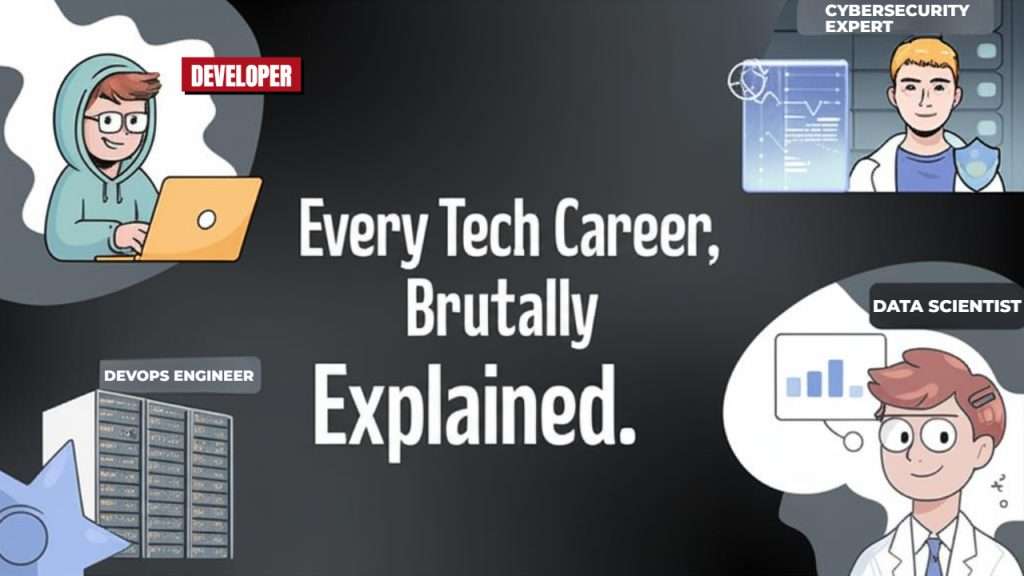Beginner’s Guide to Web Development (2025 Edition)
Let’s break down what web development actually is. If you’ve ever wondered how websites like YouTube, Netflix, or Amazon are built, this Beginner’s Guide to Web Development will make everything clear, even if you’ve never written a line of code before.
What Is Web Development?
Web development means building and maintaining websites. It covers everything you see (design, layout, animations) and everything you don’t see (servers, databases, authentication).
There are two main sides:
- Frontend – what users see and interact with
- Backend – what happens behind the scenes
The Frontend: What You See
Frontend development is like the face of the website, everything visible in your browser. It’s built with three main languages:
| Technology | Description |
|---|---|
| HTML | The structure or skeleton of the webpage |
| CSS | The design – colors, fonts, layout |
| JavaScript | The brain – makes the site interactive |
For example:
<!DOCTYPE html>
<html>
<head>
<title>Hello Web</title>
<style>
body { font-family: Arial; color: #333; }
</style>
</head>
<body>
<h1>Welcome to My First Webpage</h1>
<p>This is how HTML and CSS work together!</p>
<script>
console.log("JavaScript is running!");
</script>
</body>
</html>
Output:
When you open this file in a browser, you’ll see a clean page with a title, text, and if you check the console, “JavaScript is running!”
If you like instant feedback and visuals, frontend development is for you.
The Backend: What You Don’t See
Backend development is where data and logic live. It’s what happens after you click a button, like logging in or buying something online.
Common backend languages and frameworks include:
- Node.js (JavaScript)
- Python (Django / Flask)
- PHP (Laravel / WordPress)
- Java (Spring Boot)
You’ll also work with databases such as MySQL, MongoDB, or PostgreSQL to store information like users, products, or blog posts.
Here’s a tiny Node.js example:
const http = require('http');
http.createServer((req, res) => {
res.write('Hello from the backend!');
res.end();
}).listen(3000);
Output:
When you visit http://localhost:3000, you’ll see “Hello from the backend!”, that’s your first working server.
How Frontend and Backend Work Together
Here’s the thing, a website is teamwork.
- The frontend sends requests (like “get user data”).
- The backend responds with the info from the database.
They communicate using APIs (Application Programming Interfaces), usually in JSON format.
Full-Stack Development
If you learn both frontend and backend, you become a Full-Stack Developer. That means you can build an entire application, from the interface to the database.
Typical full-stack tools in 2025:
- Frontend: React, Next.js, Vue
- Backend: Node.js, Express, or Spring Boot
- Database: MongoDB or PostgreSQL
- Hosting: Vercel, AWS, or DigitalOcean
Where to Start as a Beginner
Here’s a simple roadmap:
- Learn HTML, CSS, JavaScript (the core trio).
- Build small projects like a portfolio, calculator, or to-do app.
- Learn Git & GitHub to manage your code.
- Move on to React or Next.js for modern web apps.
- Learn a backend language, start with Node.js or Python.
- Explore databases (MongoDB, MySQL).
- Deploy your project online.
Once you’ve built 2–3 small projects, you’ll understand how everything connects.
Web Development Tools You’ll Actually Use
- VS Code – your coding editor
- Chrome DevTools – for debugging websites
- Postman – to test APIs
- GitHub – for version control
- Netlify / Vercel – for free hosting
These are what real developers use daily.
Why Learn Web Development in 2025
The demand for developers is massive. Businesses, startups, and creators all need websites and apps, and that’s not changing anytime soon.
Web development also gives you creative control: you can build your own portfolio, apps, or business tools from scratch.
If you’re consistent, you can go from beginner to job-ready in 6–12 months.
Related Reads
- The Ultimate Career Guide for Computer Science Graduates
- ChatGPT’s Viral AI-generated anime Feature!
- Learn Java Basics (Day 1) – Install JDK and Run Your First Program
For external resources:
- MDN Web Docs (Mozilla) – the best place to learn HTML, CSS, and JavaScript.
- W3Schools – easy examples for quick reference.
Final Thoughts
This Beginner’s Guide to Web Development is just your starting point. Start small, stay consistent, and build things that interest you. Every website you create is proof of your progress.
Once you’re comfortable with the basics, explore frameworks like React and Node.js, that’s where modern web magic happens.







